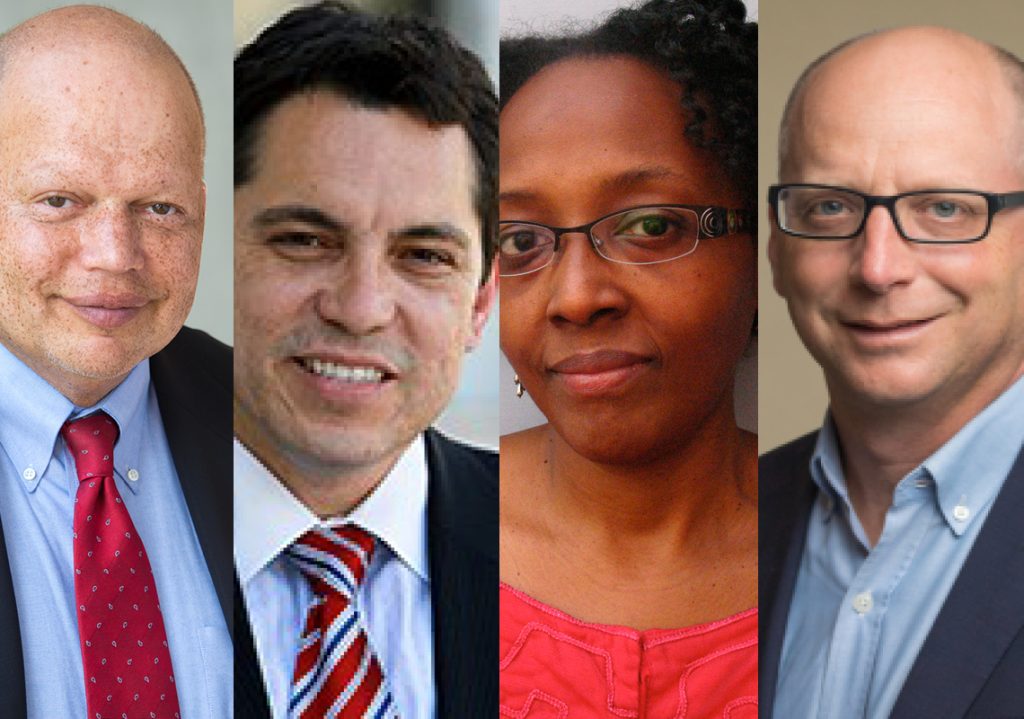On February 7, the Rappaport Center for Law and Public Policy hosted a lively debate about the future of affirmative action policies in the United States. The virtual panel, co-sponsored by BC Law’s Diversity, Equity, Inclusion, and Belonging Committee (DEIB), comes at a critical point for affirmative action, as the Supreme Court deliberates in two cases that could upset the established jurisprudence.
The panel, called “Affirmative Action: Where We’ve Been, Where We’re Going,” was moderated by Professor Theodore M. Shaw, director of the Center for Civil Rights at University of North Carolina. Shaw—who spent more than twenty-six years with the NAACP Legal Defense Fund (LDF) litigating education, housing, and voting rights issues—gracefully led the panelists and encouraged substantive engagement with the issues. Joining him were David Hinojosa, director of the Educational Opportunities Project at the Lawyers’ Committee for Civil Rights Under Law; Marjorie Salvodon, professor of history, language and global culture at Suffolk University; and Patrick Strawbridge, partner at Consovoy McCarthy. In the recent cases, Strawbridge argued on behalf of the plaintiffs, Students for Fair Admissions, to the Supreme Court; Hinojosa argued for one of the defendants, the University of North Carolina.
Shaw set the scene, offering a succinct analysis of the US Supreme Court’s 1978 decision in Regents of the University of California v. Bakke upholding affirmative action policies and the 2003 decision in Grutter v. Bollinger, which reaffirmed them. The current Supreme Court, recently emboldened by a 6-3 conservative supermajority, has heard two cases this term—Students for Fair Admissions, Inc. v. President and Fellows of Harvard College and Students for Fair Admissions, Inc. v. University of North Carolina, commonly called the “Harvard and UNC cases”—with decisions expected to come at the end of the Supreme Court term.
“Conservatives never accepted Bakke,” Shaw opined. “They have been bent on getting it overturned… sounds like another case that you all can probably bring to mind. This Supreme Court is the court that conservatives have wanted for so long, and many people think that they know what the outcome is likely to be,” he went on to say, in a clear allusion to the overturning of Roe v. Wade last year.
Strawbridge made the case for the opposition, pointing out the perceived dangers of race-based discrimination in college admissions programs. He drew comparison to the 1944 Korematsu decision (which upheld the forced removal and incarceration of more than 125,000 Japanese Americans during WWII), calling it an “obvious example of people thinking that they had a good reason to justify discrimination on the basis of race that we all now—correctly—view as a tragically mistaken decision that imposed a lot of harm.”
According to Strawbridge, little debate remains over whether college admissions programs are holistic; race is taken into account only as a single factor among many as mandated by Grutter. However, Strawbridge argued that “by necessity, a holistic admissions process means that, for some number of students in any given year, the race factor will be the one that elevates them from the discard pile into the acceptance pile.” He continued by positing that universities can obtain equal diversity through race neutral means, particularly socio-economic status.
Hinojosa and the Lawyers’ Committee represent a multiracial group of student intervenors in the UNC case, the only students to have testified during arguments. Hinojosa was refreshingly hopeful about the future of affirmative action in this country: “I am one of the few who will say this, but I believe that we will win. If the Court holds allegiance to the letter of law, the Constitution, precedent, and the incredible record developed in these cases, we win,” he said. Strongly disagreeing with Strawbridge, Hinojosa stated that utilizing socio-economic status does not result in greater diversity, referencing 100 models that had been run.
Salvodon brought a healthy dose of outside perspective, reframing the debate not in terms of the actual legal language used but in the underlying meaning of the language: “What is the action behind all of these words: affirmative action or inclusion or diversity? I think they’re reaching for a sort of redress, to grapple with what we have inherited,” she said. She predicted that a blow to affirmative action would be “disastrous not only for those who sit in the classrooms, but those who get to teach,” as well as experiences, thought perspectives, and the quality of thinking both in this country and the world.


